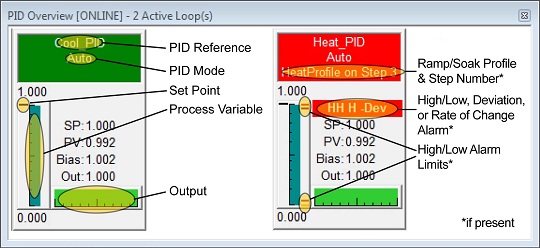Topic: DMD0242
The PID Overview
The PID Overview is a container that will display a boilerplate for each Closed Loop Controller (PID) instruction used in a Do-more Designer project. The boilerplate for each PID Loop displays the most commonly needed runtime values and alarming information (if available).

The boilerplate is broken into two sections: the upper section uses color to quickly convey the current status of the PID loop, and the lower section contains graphs and numeric displays to show the runtime details of the PID loop.
The upper section of each boilerplate displays three pieces of data:
The PID Loop reference.
The current Mode of the PID Loop.
If there is a Ramp/Soak Profile (RAMPSOAK) instruction controlling the Loop's SetPoint, the Ramp/Soak Reference and the current step in the profile will also be displayed.
The background color of the upper section will change to reflect the
current mode of the loop any alarm status. The potential colors of the
background are:
GREEN if the Loop is in Auto mode
NORMAL BACKGROUND if the loop is in Manual mode
YELLOW if the loop is in an Auto-tune cycle
RED if there is an associated High/Low Alarm (ALHILO), Deviation Alarm (ALDEV), or Rate of Change Alarm (ALRATE) instruction that is currently registering an alarm.
The lower section of the boilerplate consists of two bar graph displays and 4 value displays as follows:
The vertical graph displays the current Process Variable (PV).
The small bar to the left of the PV Bar is the current Set Point.
The horizontal graph displays the current Output value.
The 4 value displays show the current Set Point, Process Variable, Bias and Output values in numeric form.
If there is a High/Low Alarm instruction referencing the loop's Process Variable, the alarm limits from that instruction will be shown on the right side of the vertical bar graph, and if that High/Low Alarm instruction is currently in alarm, the alarm status ( HH, H, L, LL ) will be shown above the value displays.
If there is a Deviation Alarm instruction referencing the loop's Process Variable, and that instruction is currently in alarm, the alarm status ( -Dev, +Dev )will be shown above the value displays.
If there is a Rate of Change Alarm instruction referencing the loop's Process Variable, and that instruction is currently in alarm, the alarm status ( -Rate, +Rate ) will be shown above the value displays.
See Also:
Process Control Instruction Set
The PID Overview
Using the PID Process Simulator
Related Topics:
PID Calculation and Tuning Constants
PIDINIT - Set PID Tuning Constants
Alarm Handlers
Input and Output Value Limiters
DEADBAND - Set Outside Deadband
Noise Suppression
INTEGRAT - Integrate Over Time
Ramp/Soak Profiles - up to 250 steps per Profile
Input and Output Scaling
Analog Control using a Discrete Output
TIMEPROP - Time Proportional Control
